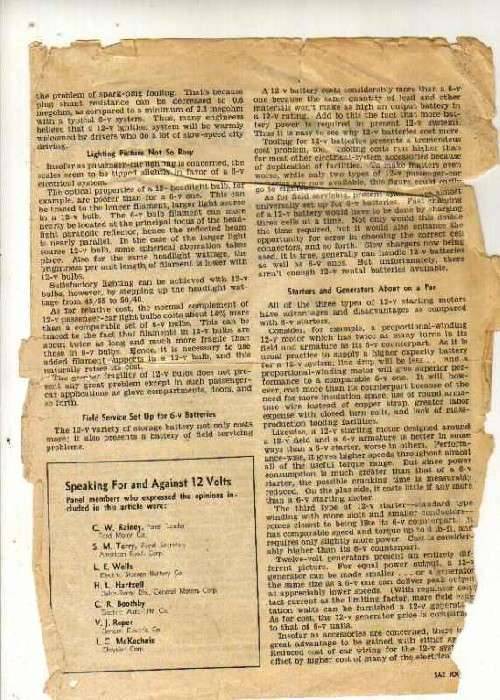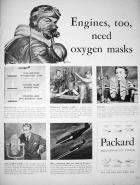|
Re: Let's discuss Packard 6V electrical systems and the change to 12V systems
|
||||
|---|---|---|---|---|
|
Home away from home
|
G'day all, I personally haven't seen any low voltage 6 or 12 v valve mantle radio sets installed in houses in Australia, but they would almost certainly have been Automotive radio sets. Our domestic supply is 240 v ac and most early farms not connected to a domestic grid used a 32 v DC system . Mantle Radio sets (valve) in Australian households were 220-240 volts but I understand that US valve radio mantle sets at 110 volts were the ones used in cars, powered by either 6 or 12 V DC. The DC was converted to AC by a multi-vibrator, then transformed up to the 110v. (I am not sure if the high voltage portion of valve radios in European cars were 220v or 110 volts) (The valve heaters would have remained at 6v or 12V DC). The multivibrators are identical to those used in a 6V Packard valve radio. The early car radios were not very efficient and used to draw around 10 amps (6V) or 6 amps (12). Anyone who had been at the drive-in using the clip-on lead onto your 6V car aerial would attest to the two hour drain on the cars battery. I am an electrical tradesman but am not a radio technician, so some of my explanations may not be fully correct. best regards Peter Toet.
Posted on: 2008/7/2 1:47
|
|||
|
I like people, Packards and old motorbikes
|
||||
|
||||
|
Re: Let's discuss Packard 6V electrical systems and the change to 12V systems
|
||||
|---|---|---|---|---|
|
Home away from home
|
Here is an attempt to post the 12V presents it's case article. To read each page you will have to "save as" into a file on your computer. Then you will be able to enlarge and read the pages. I find the article fascinating and it gives me some responses to some people who believe that 6V was not a good system. Peter Toet
Posted on: 2008/7/2 1:58
|
|||
|
I like people, Packards and old motorbikes
|
||||
|
||||
|
Re: Let's discuss Packard 6V electrical systems and the change to 12V systems
|
||||
|---|---|---|---|---|
|
Just can't stay away
|
MONKEY WRENCH - not to interrupt but - Chevy had a 8 volt battery in some of their 1954 pickup trucks. It would crank the engine over like mad. Sure had no problems firing it up in the winter time. All bulbs were 6 volt.
When the old 8 volt died I tried a new 6 volt battery but there wasn't enough power to start it. I went nuts looking for a new 8 volt and finally had to have one made.
Posted on: 2008/7/2 11:16
|
|||
|
||||
|
Re: Let's discuss Packard 6V electrical systems and the change to 12V systems
|
||||
|---|---|---|---|---|
|
Home away from home
|
G'day Redron, 8 Volt batteris were very popular here in Australia in the fifties and Sixties, especially for 6V Holden and Volkswagen vehicles. I had one on my 38 Packard Six for 5 years but i ended up going back to 6V because the voltage regulator was not temperature compensating. If you started the car at night your generator was charging at up to 11.5 volts, dropping down to the 9.6 volts required to keep the 8 volt battery charged when the regulator warmed up. If I put the lights on within a minute of starting it used to cause early failure of the bulbs, mainly parkers and instrument, not usually the headlight ones rated at 6-8 volts. The other problem was that many of the early Packards did not have headlight relays and the ammeter copped a pounding and used to get very hot ( unless you used lights or some other load to cut the charge rate down). I still have a brand new uncomissioned 8V battery but I will probably never use it. Best regards Peter Toet
Posted on: 2008/7/2 18:19
|
|||
|
I like people, Packards and old motorbikes
|
||||
|
||||
|
Re: Let's discuss Packard 6V electrical systems and the change to 12V systems
|
||||
|---|---|---|---|---|
|
Home away from home
|
G'day all, especially Packard V8. Your statement and question about US households in 1920-1950 having a radio that was powered by a car battery etc.... got me looking around and sure enough there were many of them in the US ( not sure about Australia) and they were run from 32v DC, 110ac and 110 dc . They required an "A" battery, a "B" battery and a "C" battery.
The A battery was an automotive type battery, usually of 6v which powered the valve filaments. This was recharged by whatever the generated voltage in the home was, and it could be mains or self generated, via rectifiers for AC or shunts ( such as light bulbs) for DC. The "B" battery could be up to 4 batteries of up to 24 volts each to supply positive voltage pressure on the plate of the tube to which the negative electrons which are emitted from the filament may flow. It also improved the quality of the radio reception. The "B" battery was charged from the same supply as the "A" battery but sometimes had to be charged in sections ( 24v each) The "C" battery was usually a tap from within the "B" battery and functioned as a governing device to retard or accelerate the flow of electrons from the filament of the plate. A 6V Philco-Packard radio set ( for example) operates with these same three elements above. The 6v battery still supplies the valve filaments, but the "B" and "C" battery functions are supplied from the output of the multi-vibrator, which may be supplied as AC or rectified back to DC. There appeared to be quite a deal of maintenance required to keep these large "B" batteries fully charged. I have not seen one personally. The source of this information and about 20 pages more on the matter was from AUDELS RADIOMANS GUIDE, COVERING THEORY, CONSTRUCTION AND SERVICING INCLUDING TELEVISION. ELECTRONICS, 1939 reprinted 1945. Best regards Peter Toet
Posted on: 2008/7/3 7:48
|
|||
|
I like people, Packards and old motorbikes
|
||||
|
||||


 (69.10 KB)
(69.10 KB)






